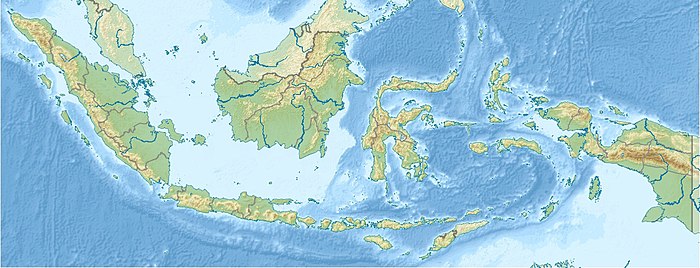Situs Tetamian Jagat ring Indonésia
Suratan niki patut katerjemahang ka basa Bali. Suratan niki kasurat utawi katerjemahang durung becik saking Wikipedia basa liyanan teken Bali. Yening kaca niki katujuang sareng komunitas mabasa punika, kaca nika pinih becik magenah ring Wikipédia basa nika. Cingak lis basa Wikipedia. Suratan sane nenten katerjemahang dados kausap manut kriteria A2. Yéning ida dané kayun nureksa suratan niki, Ida dané dados nganggén mesin panerjemah. Nanging ten engsap, ten dados nyalin asil terjemahan punika ka suratan, yadiastun kasub dados terjemahan makualitas kirang becik. |
Situs Tetamian Jagat Organisasi Paajahan, Ilmu Pawikanan, miwah Kabudayaan Paiketan Wangsa-Wangsa (UNESCO) inggih punika genah-genah kabuat antuk budaya utawi tetamian alam sekadi sané kapidartayang ring Konvénsi Tetamian Jagat UNESCO, kaadegang ring warsa 1972.[1] Tetamian budaya puniki luiré monumén (minakadi karya arsitéktur, patung monuméntal, utawi prasasti), sekaa wangunan, miwah situs (rumasuk situs arkeologi). Fitur alami (luiré formasi fisik miwah biologis), formasi géologis miwah fisiograpis (rumasuk habitat spésiés buron miwah entikan sané kaancem punah), miwah situs alam sané kabuat saking cingakan ilmu pawikanan, konservasi utawi alam ngulangunin, kadéfinisiyang dados tetamian alam.[2]
Républik Indonésia ngaratifikasi konvénsi Situs Tetamian Jagat ring tanggal 6 Juni 1989, sapunika situs malelintihan ngajangkepin prasyarat antuk ngaranjing ring lis.[3] Per tanggal 2021[update], wénten sanga Situs Tetamian Jagat ring Indonésia, lima riantara nyané budaya miwah papat palemahan. Ngaranayang Indonésia madué situs tetamian pinih akéh ring Asia Kelod Kangin.[4] Papat situs kapertama sané ngaranjing ring lis punika Candi Borobudur, Candi Prambanan, Taman Nasional Ujung Kulon, miwah Taman Nasional Komodo, sané katetapang ring warsa 1991. Pawewehan pinih anyar ngarajing lis punika Tetamian Tambang Batubaa Ombilin Sawahlunto ring warsa 2019. Ring warsa 2011, Tetamian Wana Sabeh Tropis Sumatera ngaranjing ring Lis Tetamian Jagat ring Marabaya, krana anceman paborosan, panarungan liar, parambahan pertanian, miwah rencana antuk pawangunan margi ngentasin situs.[5] Tiosan punika, Indonésia madué 19 situs ring lis téntatif.[3]
UNESCO nyantumang situs ring sor dasa kriteria; sawilang situs patut ngajankepin sakirangné silih sinunggil kriteria. Kriteria i ngantos vi maciri kultural, sapunika vii ngantos x maciri palemahan.[6]
| Site | Image | Location | Data UNESCO | Warsa kadaftar | Pidarta |
|---|---|---|---|---|---|
| Candi Borobudur | 
|
Kabupatén Magelang, Jawa Tengah | 592; Budaya: (i), (ii), (vi) |
1991 | Candi Budha sané kaloktah puniki, maasal saking abad ka-8 miwah ka-9, magenah ring Jawa Tengah. Punika kawangun ring tiga tingkatan: dasar piramida antuk lima ampik persegi konsentris, batang kerucut antuk tiga platform ngelingkeh miwah, ring duur, satunggal stupa monuméntal. Tembok miwah langkan kaukir antuk reliéf éndé sané alus, antuk jimbar total 2.500 m². Ring saiteran platform ngelingkeh wénten 72 stupa kerawang, soang-soang madaging patung Buddha. Monumén puniki kapugar antuk wantuan UNESCO ring warsa 1970-an.[7] |
| Sumbu Kosmologis Yogyakarta miwah Wangunan Malelintihané | 
|
Daerah Istimewa Yogyakarta | 1671; Budaya: (ii), (iii) |
2023 | Pusat kasultanan provinsi lan acara kabudayaan niki kabuka ring abad ka-18 olih Hamengkubuwono I. Mapaiketan sareng sradha jadma Jawa indik kosmos lan pitehan kauripan, 6-kilométer (3.7 mi) porosné ngbungang Gunung Merapi (kalér) lan Samudra Hindia (kelod), mapusat ring Keraton Yogyakarta (foto) lan monumén liyanan ring sejeroning porosné, sané kahubungang nganggén upacara adat.[8] Situs niki sadurungné ngeranjing lis tentatip dados Pusat Kota Malelintihan Yogyakarta ring warsa 2017, antuk kriteria i, ii, lan vi.[9] |
| Lanskap Budaya Provinsi Bali: Sistem Subak Dados Manifestasi saking Tattwa Tri Hita Karana | 
|
Bali | 1194rev; Budaya: (iii), (v), (vi) |
2012 | Lanskap budaya Bali terdiri dari lima sawah dan pura airnya yang mencakup 19.500 ha. Candi adalah fokus dari sistem pengelolaan air bersama untuk kanal dan bendung, yang dikenal sebagai subak, yang berasal dari abad ke-9. Termasuk dalam lanskap adalah Kuil Air Kerajaan abad ke-18 dari Pura Taman Ayun, bangunan arsitektur terbesar dan paling mengesankan dari jenisnya di pulau itu. Subak mencerminkan konsep filosofis Tri Hita Karana, yang menyatukan alam ruh, dunia manusia dan alam. Filosofi ini lahir dari pertukaran budaya antara Bali dan India selama 2.000 tahun terakhir dan telah membentuk lanskap Bali. Sistem subak dari praktik pertanian yang demokratis dan egaliter telah memungkinkan orang Bali menjadi petani padi paling produktif di nusantara meskipun ada tantangan untuk mendukung populasi yang padat.[10] |
| Taman Nasional Komodo | 
|
Kabupatén Manggarai Barat, Nusa Tenggara Timur | 609; Palemahan: (vii), (x) |
1991 | Pulau-pulau vulkanik ini dihuni oleh sekitar 5.700 kadal raksasa, yang penampilan dan perilaku agresifnya telah menyebabkan mereka disebut 'komodo'. Mereka tidak ada di tempat lain di dunia dan sangat menarik bagi para ilmuwan yang mempelajari teori evolusi. Lereng bukit sabana kering yang terjal dan kantong vegetasi hijau berduri sangat kontras dengan pantai berpasir putih yang cemerlang dan air biru yang bergelombang di atas karang.[11] |
| Taman Nasional Loréntz | 
|
Papua | 955; Palemahan: (viii), (ix), (x) |
1999 | Taman Nasional Lorentz (2,35 juta ha) adalah kawasan lindung terbesar di Asia Tenggara. Ini adalah satu-satunya kawasan lindung di dunia yang menggabungkan transek utuh dan berkelanjutan dari lapisan salju hingga lingkungan laut tropis, termasuk lahan basah dataran rendah yang luas. Terletak di titik pertemuan dua lempeng benua yang bertabrakan, daerah ini memiliki geologi yang kompleks dengan pembentukan gunung yang berkelanjutan serta pemahatan besar oleh glasiasi. Daerah ini juga berisi situs fosil yang memberikan bukti evolusi kehidupan di New Guinea, tingkat endemisme yang tinggi dan tingkat keanekaragaman hayati tertinggi di kawasan ini.[12] |
| Candi Prambanan | 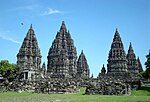
|
Jawa Tengah miwah Daerah Istimewa Yogyakarta | 642; Budaya: (i), (iv) |
1991 | Dibangun pada abad ke-10, ini adalah kompleks candi terbesar yang didedikasikan untuk Siwa di Indonesia. Menjulang di atas pusat bujur sangkar terakhir ini adalah tiga candi yang dihiasi dengan relief yang menggambarkan epos Ramayana, didedikasikan untuk tiga dewa besar Hindu (Siwa, Wisnu dan Brahma) dan tiga kuil yang didedikasikan untuk hewan yang melayani mereka.[13] |
| Tambang Batu Baa Ombilin Tetamian Sawahlunto | 
|
Sumatera Barat | 6057; Budaya: (ii),(iv) |
2019 | Dibangun untuk ekstraksi, pemrosesan, dan pengangkutan batubara berkualitas tinggi di wilayah Sumatera yang sulit dijangkau, situs industri ini dikembangkan oleh pemerintah kolonial Belanda dari akhir abad ke-19 hingga awal abad ke-20 dengan tenaga kerja yang direkrut dari penduduk setempat dan dilengkapi dengan tenaga kerja narapidana dari daerah-daerah yang dikuasai Belanda. Ini terdiri dari lokasi pertambangan dan kota perusahaan, fasilitas penyimpanan batubara di pelabuhan Emmahaven dan jaringan kereta api yang menghubungkan tambang ke fasilitas pantai. Warisan Pertambangan Batubara Ombilin dibangun sebagai sistem terintegrasi yang memungkinkan ekstraksi, pemrosesan, pengangkutan, dan pengiriman batubara dalam lubang dalam yang efisien.[14] |
| Situs Manusa Purba Sangiran | 
|
Kabupatén Sragén, Jawa Tengah | 593; Budaya: (iii), (vi) |
1996 | Penggalian di sini dari tahun 1936 hingga 1941 menghasilkan penemuan fosil hominid pertama di situs ini. Kemudian, 50 fosil Meganthropus palaeo dan Pithecanthropus erectus/Homo erectus ditemukan – setengah dari semua fosil hominid yang diketahui di dunia. Dihuni selama satu setengah juta tahun terakhir, Sangiran adalah salah satu situs kunci untuk memahami evolusi manusia.[15] |
| Tetamian Wana Sabeh Tropis Sumatera† | 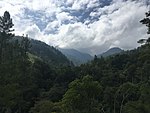
|
Aceh, Jambi, lan Lampung | 1167; Palemahan: (vii), (ix), (x) |
2004 | Situs Warisan Hutan Hujan Tropis Sumatera seluas 2,5 juta hektar terdiri dari tiga taman nasional: Taman Nasional Gunung Léuser, Taman Nasional Kerinci Seblat lan Taman Nasional Bukit Barisan Selatan. Situs ini memiliki potensi terbesar untuk konservasi jangka panjang dari biota khas dan beragam Sumatera, termasuk banyak spesies yang terancam punah. Kawasan lindung adalah rumah bagi sekitar 10.000 spesies tanaman, termasuk 17 genus endemik; lebih dari 200 spesies mamalia; dan sekitar 580 jenis burung dimana 465 adalah penduduk dan 21 adalah endemik. Dari spesies mamalia, 22 adalah Asia, tidak ditemukan di tempat lain di nusantara dan 15 terbatas di wilayah Indonesia, termasuk endemik Orangutan Sumatera. Situs ini juga menyediakan bukti biogeografis dari evolusi pulau tersebut. Situs ini telah terdaftar sebagai terancam punah sejak 2011 karena perburuan liar, penebangan liar, perambahan pertanian, dan rencana untuk pembangunan jalan.[16][17] |
| Taman Nasional Ujung Kulon | 
|
Banten miwah Lampung | 608; Natural: (vii), (x) |
1991 | Taman nasional ini terletak di ujung paling barat daya Jawa di paparan Sunda, meliputi semenanjung Ujung Kulon dan beberapa pulau lepas pantai dan meliputi cagar alam Krakatau. Selain keindahan alam dan minat geologisnya – khususnya untuk studi tentang gunung berapi pedalaman – kawasan ini memiliki kawasan hutan hujan dataran rendah terbesar yang tersisa di dataran Jawa. Beberapa spesies tumbuhan dan hewan yang terancam punah dapat ditemukan di sana, badak Jawa menjadi yang paling serius terancam.[18] |
The following 19 sites are on the Tentative List for Indonesia, meaning that the government intends to consider them for nomination in the future:[19]
| Situs | Gambar | Genah | Data UNESCO | Jimbar ha (akre) |
Warsa | Pidarta | Pust. |
|---|---|---|---|---|---|---|---|
| Situs Bawomataluo | 
|
Kabupatén Nias Kelod, Nias, Sumatra Kalér 00°36′59″N 97°46′17″E / 0.61639°N 97.77139°E |
5463; Budaya: (i), (iv), (vi) |
5 ha | 2009 | Located in the Teluk Dalam province of the South Nias Regency, it is believed to have originated back to the 18th century. Large stone slabs stand in front of the houses and an open space in the center of the village is used for traditional ceremonies and rituals. | [20] |
| Taman Nasional Betung Kerihun (Tetamian Wana Sabeh Lintas Wates Kalimantan) | 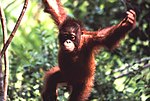 |
Kalimantan Kauh 0°40′0″N 112°15′0″E / 0.66667°N 112.25000°E |
1871; Palemahan: (viii), (ix), (x) |
800,000 ha | 2004 | Betung Kerihun National Park (BKNP) is located at the headwaters of the Kapuas River in the far interior of Kalimantan Barat (;Western Kalimantan) Province. The site covers an area of 800,000 Ha and borders the 200,000 Ha Lanjak Entimau Wildlife Sanctuary (LEWS) in Sarawak, Malaysia. Together the two protected areas form one of the first trans-border parks in Southeast Asia. | [21] |
| Taman Nasional Bunakén | 
|
Manado, Sulawesi Kalér 1°35′0″N 124°39′0″E / 1.58333°N 124.65000°E |
2002; Palemahan: (vii), (viii), (ix), (x) |
280,000 ha | 2005 | This part of North Sulawesi was undergone multiple geologic stages. It is considered to be a "young" continent of 5–24 million years of age which has undergone explosive volcanism more recently (1.5 to 5 million years ago) which resulted in the volcanic tuff that characterizes the existing topography. Manado Tua is an inactive volcano formed in a classical cone shape with a 27–45-ft slope. The island rises over 600 m above sea level, the highest elevation in the park. Bunaken Island has volcanic origins with a significant amount of uplifted fossil coral. At the west and central part of Bunaken Island (71 m high) there is a flat plateau about 5Om above mean sea level (msl). Nain Island is also a dome-shaped island, 139 m in height and with a slope of 20–40 inches. Mantehage Island is relatively flat and seems to be sinking into the sea. The island has extensive mangrove forest flats, partially separated by saltwater channels. Siladen is a low-lying coral sand island with no significant topography. Arakan-Wawontulap and Molas-Wori on the mainland of North Sulawesi are relatively flat areas at the base of volcanic hills. | [22] |
| Kapuloan Derawan | 
|
Kabupatén Berau, Kalimantan Kangin 2°15′0″N 118°25′0″E / 2.25000°N 118.41667°E |
2007; Palemahan: (x) |
—
|
2005 | Stretching over 100 miles along the coast of East Kalimantan, the Derawan island chain is one of the most biologically rich areas in all of Indonesia. Here, water from the Berau River mixing with the Sulawesi Sea created a unique seascape characterized by a broad river delta leading to a scattered groupings of patch reefs, fringing reefs, and atolls. | [23] |
| Lanskap Lelintihan lan Kasegaraan Kapuloan Banda | 
|
Kabupatén Maluku Tengah, Maluku 40°28′0″S 129°39′0″E / 40.46667°S 129.65000°E |
6065; Campuhan: (iv), (vi), (x) |
—
|
2015 | The Banda Islands are also known under the name 'Spice Islands’, as this island group was the original and sole location of the production of the spices nutmeg and mace during the most prosperous years of Dutch, English and Portuguese colonization. The Banda Islands are situated in the eastern part of the Indo-Malayan archipelago. It consists of eleven small volcanic islands, called Neira, Gunung Api, Banda Besar, Rhun, Ai, Hatta, Syahrir, Karaka, Manukan, Nailaka and Batu Kapal, with an approximate land area of 8,150 hectares in total. These islands were the scene of the earliest European ventures in Asia. | [24] |
| Kebun Raya Bogor | 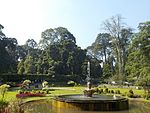
|
Bogor, Jawa Kauh 6°36′13.28″S 106°48′17.6″E / 6.6036889°S 106.804889°E |
6353; Budaya: (ii), (iv) |
75.4 ha | 2018 | Kebun Raya Bogor or Bogor Botanic Gardens (BBG) is an ex situ conservation area located in the administrative area of Bogor City, West Java Province, Indonesia. Area of BBG was 75.4 ha. Bogor Botanical Garden is at N 6º35‟32.78" S 6º36‟13.28" W 106º47‟36.72" E 106º48‟17.6". Bogor Botanic Gardens is one of the plant conservation areas that became important evidence in the historical development of science in Indonesia. There are more than 24 research institutions on natural sciences directly and directly established by Bogor Botanic Gardens located in Buitenzorg/Bogor. In the beginning the establishment of Bogor Botanic Gardens was intended as a place of acclimatization of plant species originating from foreign countries that have high economic value. Now, Bogor Botanic Gardens not only conserve the types of economic value, but also conserve the species of plants that are rare, endemic, scientific value and have the potential to be developed from the entire tropics. Collection of plants arranged in the form of blocks and grouped by taxonomic and thematic classification pattern. | [25] |
| Muara Takus Compound Site | 
|
Kabupatén Kampar, Riau 0°20′20″N 100°38′24.62″E / 0.33889°N 100.6401722°E |
5464; Budaya: (i), (iv), (vi) |
—
|
2009 | Muara Takus Site is administratively under the Muara Takus village, in the district of Koto Kampar XIII, which is situated in the Kampar regency of Riau province. The Kampar Kanan river divides Muara Takus into two regions. The river flowing northward forms a parabolic river bend. In the eastern side of the river, there is a small river which is known by the local people as the Umpamo or Limpamo river. The headwaters of this small river is located in the swamp areas in the southeast of Muara Takus and this small river ends in the Kampar Kanan River. The estuary of the Umpamo or Limpamo river is situated exactly at the northernmost curve of the Kampar Kanan River. In the past, a human settlement was situated at the inner side and northern side of the river bend, but more specifically in the eastern side of the river. However, due to the hydro-power electricity plant development project, both sub-village regions were relocated to a new location approximately 1.5 kilometres southwards of the former settlement. | [26] |
| Muara Jambi Temple Compound | 
|
Kabupatén Muaro Jambi, Jambi 1°24′0″S 103°2′0″E / 1.40000°S 103.03333°E |
5465; Budaya: (ii), (iii), (iv) |
2062 ha | 2009 | The Muarajambi Temple Compound Site is located in the Muarajambi Village, in the District of Maro Sebo, Muaro Jambi Regency, Jambi Province. From Jambi city, the site is less than 40 kilometers and can be reached by land transportation or through the river in one hour. The site is spread along 7.5 kilometers of the riverbanks of Batanghari River in which old canals or man-made rivers are positioned to connect the Batanghari River with the site. Through these ancient canals that circulate the site, people could reach the temple compounds. In the Muarajambi Temple Compound Site that covers an area of 2062 hectares, there were at least 82 ruins of ancient buildings made of brick construction. Seven of these ancient temples have been given intensive conservation treatment; meanwhile the remaining structures are covered with primary and secondary vegetation, and surrounded by the local community plantation of Sumatran endemic plants (planted by the local people known as Menapo). The seven temple compounds are the Gumpung, Tinggi I, Tinggi II, Kembar Batu, Astano, Gedong I and Gedong II, and the Kedaton Temple. In addition to that conservation treatment, several of the ancient canals and the old ponds that were previously covered with water vegetation have been cleared and are now restored to normal, such as the ancient canals in Jambi River and the Telago Rajo Pond. Based on archaeology research and historical sources, the Muarajambi Temple Compound Site was once the centre for worship and education of the Buddhist religion in the period of the Ancient Malay Kingdom in the 7th–14th centuries AD. | [27] |
| The Old Town of Jakarta (Formerly old Batavia) and 4 Outlying Islands (Onrust, Kelor, Cipir dan Bidadari) | 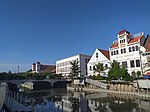
|
Jakarta 6°08′05″S 106°48′48″E / 6.13472°S 106.81333°E |
6010; Budaya: (ii),(iii),(iv),(v) |
- | 2015 | Located at the mouth of the Ciliwung River in Java, the Old Town of Jakarta was established by the VOC in 1619. Its 17th-century town plan was completed in 1650. In 17th and 18th century VOC had largest volume of trade in the world, governed from Batavia. No colonial town built by VOC matched the grandeur and completeness (military, civil engineering, and urban elements) of Dutch town planning & architecture of Batavia. The nominated property: the 1650 town (1.5 km x 1 km) with 4 major areas on the Ciliwung River sides. West side: former Jayakarta and two 18th century houses. Northwest side: West Warehouse, old town wall remains, Floating Warehouse, VOC shipyard, Luar Batang Mosque. East side: East Warehouse, Town Square, Town Hall. South east side: China Town. Kalibesar Canal with traditional boats wharf. Islands: Onrust, Kelor, Cipir & Bidadari with shipyard and forts. | [28] |
| Prehistoric Cave Sites in Maros-Pangkep | 
|
Kabupatén Maros, Sulawesi Kelod 4°42′49″S 119°34′17″E / 4.71361°S 119.57139°E |
5467; Natural: (ix) |
21,631 ha forest area, 43,750 ha the Karst Maros-Pangkep area | 2009 | In general, the karst landscape is hilly and has mountainous terrains. The mountainous area is situated in the north east or located in the Bulusaraung Mountains. The highest peak of the mountain is 1,565 m above sea level in the northern side of Bulusaraung Mountain. This side of the mountain has a steep slope with rough texture. The climate in the Maros Pangkep area is tropical with the dry season between the months of November to April meanwhile the rainy season runs from May to October. The temperature ranges from 210–310 °C or on average 26.40 °C, with fluctuating humidity. The area of the Pangkep conservation forest covers around ± 21.631 hectares from the total forest area of 32.503 hectares. Most of the conservation forest is within the karst area that is part of the National Park of Bantimurung and Bulusaraung (Babul). | [29] |
| Raja Ampat Islands | 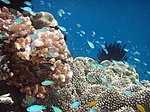
|
West Papua province 0°30′0″N 124°30′0″E / 0.50000°N 124.50000°E |
2003; Natural: (vii), (x) |
4.6 million ha | 2005 | The Raja Ampat Islands, situated near the Northwest coast of Papua, consists of about 1,500 islands, including several large, mountainous islands, the largest being Waigeo, Batanta, Salawati and Misool. The land and surrounding sea occupy approximately 46,000 sq km or about 4.6 million ha. The islands are located in a region on the western boarder of the equatorial Pacific Ocean and at the Northeastern ‘entrance’ of the Indonesian Throughflow from the Pacific to the Indian Ocean. The vast majority of the archipelago rests on the Sahul shelf. The wide distribution of small islands across the shelf edge creates a strong gradient from clear water, open oceanic conditions to sheltered and turbid bays, surrounded by karst limestone formations. | [30] |
| Sangkulirang – Mangkahilat Karts: Prehistoric rock art area | 
|
East Kalimantan 1°09′39.12″N 117°09′32.62″E / 1.1608667°N 117.1590611°E |
6009; Cultural: (iii) |
- | 2015 | The property is situated in the middle-eastern part of East Kalimantan Province, at Sangkulirang-Mangkalihat Peninsula. It contains thousands of red rock-art paintings, and some sites with engraving located at 35 sites in seven different karst mountain areas at the head of the Sangkulirang-Mangkalihat Peninsula (Merabu, Batu Raya, Batu Gergaji, Batu Nyere, Batu Tutunambo, Batu Pengadan and Batu Tabalar). | [31] |
| Semarang Old Town | 
|
Semarang, Central Java 6°58′06″S 110°25′40″E / 6.96833°S 110.42778°E |
6011; Cultural: (ii),(iv) |
- | 2015 | Semarang is a colonial city par excellence. Established in 17th century, Kota Lama Semarang is a best preserved colonial city with remarkable testimony of important historical phases of human civilization – in economic, political and social – in the South East Asia and the World. Although it is today a sprawling metropolis of 1.2 million inhabitants, its old centre retains a group of buildings with various architectural styles coming from medieval, baroque and modern style. Its unique urban landscape shows a development of a fortified city which is growing into an international and cosmopolitan port city in its age. Therefore it is worth preserving Kota Lama Semarang, especially from today’s thread: extensive flooding and land subsidence. | [32] |
| Taka Bonerate National Park | 
|
Selayar Regency, South Sulawesi 6°16′0″S 120°54′0″E / 6.26667°S 120.90000°E |
2005; Natural: (vii), (viii), (ix), (x) |
530,765 ha | 2005 | The Bonerate National Park is home to the third biggest atoll in the world after Kwajifein in the Marshall Isles and Suvadiva in the Moldiva Isles. The total area of the atoll is about 220,000 hectares with coral reefs spreading over 500 sq km. The national park includes an area of 530,765 ha. Taka Bonerate is a Bugis’ name that somewhat has a meaning coral piled up on sand. There are 15 islands in Taka Bonerate National Park where visitors can enjoy diving, snorkelling and marine tours. | [33] |
| Tana Toraja Traditional Settlement | 
|
Tana Toraja Regency, South Sulawesi 2°36′0″S 119°22′0″E / 2.60000°S 119.36667°E |
5462; Cultural: (iv), (v), (vi) |
3,205 km2 | 2009 | Tana Toraja Traditional Settlement is a series of 10 traditional settlements or constituents of them, such as burial or ceremonial grounds. The properties are scattered within Tana Toraja Regency in the Province of South Sulawesi, Indonesia. Tana-Toraja occupies about 3.205 sq km of a relatively hilly terrain with plateaus rising from 300 to 2,800 meters above sea level. The nominated Tana Toraja Traditional Settlement consists of 10 sites which are dispersed in the Tana Toraja Regency (see part I). Traditionally, a Toraja settlement consists of a compound of houses (tongkonan) and granaries (alangs), burials (liang), ceremonial grounds with menhirs (rante), rice-fields, bamboo forests, and grazing ground or pasture for buffalo and pigs. However, not all the nominated sites possess all the settlement components, on account of developmental changes in each site. A brief description of the nominated sites is provided in part I Identification of the Property. The following descriptions present some complementary information about each site. | [34] |
| Traditional Settlement at Nagari Sijunjung | 
|
Sijunjung Regency, West Sumatra 0°42′49″S 100°59′28″E / 0.71361°S 100.99111°E |
6059; Cultural: (iii),(v) |
- | 2015 | Traditional Settlement at Nagari Sijunjung (Perkampungan Adat Nagari Sijunjung) located at two villages, Jorong Koto Padang and Tanah Bato, of Sijunjung regency of West Sumatra. The main setting of settlement is in a linier position lies between two large rivers, namely Batang Sukam and Batang Kulampi. The compound of traditional houses is surrounded by hills, forest, paddy fields, and plantation. There are 76 houses in this area inhabited by nine clans and their subordinate clans. The traditional houses symbolize matrilineal-based clans in Nagari, customary village of Minangkabau. It consists of paddy fields and plantation, graveyards, mosques and madrasah-Islamic school, market, and balai adat (customs hall). | [35] |
| Trowulan - Former Capital City of Majapahit Kingdom | 
|
Mojokerto Regency, East Java 7°30′0″S 112°18′0″E / 7.50000°S 112.30000°E |
5466; Cultural: (i), (v) |
99 km2 | 2009 | The Trowulan site is the only city site of the Hindu-Budha classical age in Indonesia that can still be found. The site covers an area of 11 km x 9 km, which includes the Districts of Trowulan and Sooko within the Regency of Mojokerto and the Districts of Mojoagung and Mojowarno under the Jombang Regency. The site of the former capital city of the Majapahit Kingdom was built on flat terrains at the foot of three mountains, namely the Penanggungan, Welirang, and Anjasmara Mountain. Geographically, the Trowulan area was suitable for human settlement since it was supported by plane topography with relatively shallow ground water. Hundreds of thousands of archaeological remnants of the old city in the Trowulan Site were found buried underground as well as on the surface in the form of: artifacts, eco-facts, and features. | [36] |
| Wakatobi National Park | 
|
Buton Regency, Southeast Sulawesi 5°12′0″S 123°20′0″E / 5.20000°S 123.33333°E |
2006; Natural: (vii), (viii), (ix), (x) |
1,390,000 ha | 2005 | Wakatobi National Park has very high marine resource potential, in terms of both species and uniqueness, with enchanting submarine landscapes. In terms of configuration, the marine waters of the park generally start flat and then slope seawards, with sheer precipices in some parts. The water depth varies, the deepest parts reaching 1,044 metres with sand and coral at the bottom. This park has 25 chains of coral reefs, and the total circumference of the coral islands is 600 km. The National Park includes an area of 1,390,000 hectares. | [37] |
- ↑ "The World Heritage Convention". UNESCO World Heritage Centre. Kaarsipin saking versi asli tanggal 27 Agustus 2016. Kaaksés 7 Juli 2019.
- ↑ "Convention Concerning the Protection of the World Cultural and Natural Heritage". UNESCO World Heritage Centre. Kaarsipin saking versi asli tanggal 1 Pébruari 2021. Kaaksés 3 Pébruari 2021q.
- ↑ 3,0 3,1 "Indonesia". UNESCO World Heritage Centre. Kaarsipin saking versi asli tanggal 18 Nopémber 2020. Kaaksés 16 Januari 2021.
- ↑ "World Heritage List". UNESCO World Heritage Centre. Kaarsipin saking versi asli tanggal 14 Maret 2021. Kaaksés 2 Juli 2019.
- ↑ "Danger listing for Indonesia's Tropical Rainforest Heritage of Sumatra". Pusat Tetamian Jagat UNESCO. Kaarsipin saking versi asli tanggal 1 Juli 2011. Kaaksés 26 Juli 2011.
- ↑ "UNESCO World Heritage Centre The Criteria for Selection". UNESCO World Heritage Centre. Kaarsipin saking versi asli tanggal 12 June 2016. Kaaksés 17 August 2018.
- ↑ "Borobudur Temple Compounds". UNESCO. Kaarsipin saking versi asli tanggal 10 October 2017. Kaaksés 28 May 2010.
- ↑ "The Cosmological Axis of Yogyakarta and its Historic Landmarks". UNESCO World Heritage Centre. Kaarsipin saking versi asli tanggal 19 Séptémber 2023. Kaaksés 2023-09-19.
- ↑ "Historical City Centre of Yogyakarta". Pusat Situs Tetamian Jagat UNESCO. Kaarsipin saking versi asli tanggal 19 Méi 2018. Kaaksés 18 April 2018.
- ↑ "Cultural Landscape of Bali Province". UNESCO. Kaarsipin saking versi asli tanggal 5 July 2018. Kaaksés 1 July 2012.
- ↑ "Komodo National Park". UNESCO. Kaarsipin saking versi asli tanggal 3 July 2010. Kaaksés 28 May 2010.
- ↑ "Lorentz National Park". UNESCO. Kaarsipin saking versi asli tanggal 4 July 2010. Kaaksés 28 May 2010.
- ↑ "Prambanan Temple Compounds". UNESCO. Kaarsipin saking versi asli tanggal 25 December 2017. Kaaksés 28 May 2010.
- ↑ "Ombilin Coal Mining Heritage of Sawahlunto". UNESCO. Kaarsipin saking versi asli tanggal 29 September 2020. Kaaksés 8 August 2019. Check date values in:
|archive-date=(help) - ↑ "Sangiran Early Man Site". UNESCO. Kaarsipin saking versi asli tanggal 26 Desember 2017. Kaaksés 28 Mei 2010. Check date values in:
|accessdate=, |archive-date=(help) - ↑ "Tropical Rainforest Heritage of Sumatra". UNESCO. Kaarsipin saking versi asli tanggal 30 June 2011. Kaaksés 25 June 2011.
- ↑ "Danger listing for Indonesia's Tropical Rainforest Heritage of Sumatra". UNESCO. Kaarsipin saking versi asli tanggal 1 July 2011. Kaaksés 26 July 2011.
- ↑ "Ujung Kulon National Park". UNESCO. Kaarsipin saking versi asli tanggal 3 July 2010. Kaaksés 28 May 2010.
- ↑ "Tentative Lists: Indonesia". UNESCO. Kaarsipin saking versi asli tanggal 29 February 2012. Kaaksés 8 April 2012.
- ↑ "Bawomataluo Site". UNESCO. Kaarsipin saking versi asli tanggal 7 August 2012. Kaaksés 8 April 2012.
- ↑ "Betung Kerihun National Park". UNESCO. Kaarsipin saking versi asli tanggal 12 January 2012. Kaaksés 8 April 2012.
- ↑ "Bunaken National Park". UNESCO. Kaarsipin saking versi asli tanggal 12 January 2012. Kaaksés 8 April 2012.
- ↑ "Derawan Islands". UNESCO. Kaarsipin saking versi asli tanggal 6 August 2012. Kaaksés 8 April 2012.
- ↑ "Banda Islands". UNESCO. Kaarsipin saking versi asli tanggal 6 September 2015. Kaaksés 12 August 2015. Check date values in:
|archive-date=(help) - ↑ "Kebun Raya Bogor". UNESCO. Kaarsipin saking versi asli tanggal 22 July 2018. Kaaksés 22 July 2018.
- ↑ "Muara Takus Compound Site". UNESCO. Kaarsipin saking versi asli tanggal 7 August 2012. Kaaksés 8 April 2012.
- ↑ "Muarajambi Temple Compound". UNESCO. Kaarsipin saking versi asli tanggal 19 February 2020. Kaaksés 11 April 2020.
- ↑ "The Old Town of Jakarta (Formerly old Batavia) and 4 Outlying Islands (Onrust, Kelor, Cipir dan Bidadari)". UNESCO. Kaarsipin saking versi asli tanggal 15 July 2015. Kaaksés 12 August 2015.
- ↑ "Prehistoric Cave Sites in Maros-Pangkep". UNESCO. Kaarsipin saking versi asli tanggal 7 August 2012. Kaaksés 8 April 2012.
- ↑ "Raja Ampat Islands". UNESCO. Kaarsipin saking versi asli tanggal 7 August 2012. Kaaksés 8 April 2012.
- ↑ "Sangkulirang - Mangkahilat Karts: Prehistoric rock art area". UNESCO. Kaarsipin saking versi asli tanggal 8 September 2015. Kaaksés 12 August 2015. Check date values in:
|archive-date=(help) - ↑ "Semarang Old Town". UNESCO. Kaarsipin saking versi asli tanggal 4 September 2015. Kaaksés 12 August 2015. Check date values in:
|archive-date=(help) - ↑ "Taka Bonerate National Park". UNESCO. Kaarsipin saking versi asli tanggal 13 January 2012. Kaaksés 8 April 2012.
- ↑ "Tana Toraja Traditional Settlement". UNESCO. Kaarsipin saking versi asli tanggal 28 February 2012. Kaaksés 8 April 2012.
- ↑ "Traditional Settlement at Nagari Sijunjung". UNESCO. Kaarsipin saking versi asli tanggal 15 July 2015. Kaaksés 12 August 2015.
- ↑ "Trowulan - Former Capital City of Majapahit Kingdom". UNESCO. Kaarsipin saking versi asli tanggal 20 October 2019. Kaaksés 8 April 2012.
- ↑ "Wakatobi National Park". UNESCO. Kaarsipin saking versi asli tanggal 17 June 2012. Kaaksés 8 April 2012.
- CS1 errors: dates
- Kaca antuk argumén ganda ring pangrauhan mal
- Artikel yang perlu diterjemahkan dari bahasa Indonesia
- Artikel yang perlu diterjemahkan dari bahasa Indonesia Januari 2024
- Kaca Wikipédia sané ten kaindéks
- Articles containing potentially dated statements from 2021
- Articles with invalid date parameter in template
- All articles containing potentially dated statements
- Situs Tetamian Jagat UNESCO ring Indonésia

